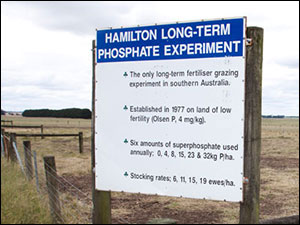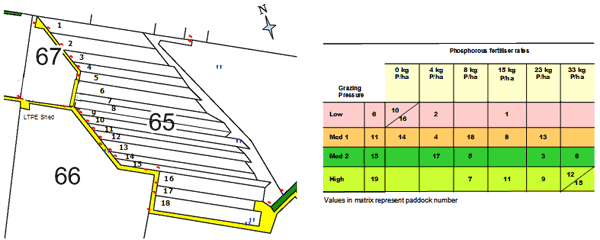Long Term Phosphate Experiment (LTPE) - Hamilton
|
The LTPE site was established in 1977 at Hamilton as a short term site to demonstrate the potential carrying capacity of improved pasture with increased phosphorus. The experiment evolved into a long term monitoring site for assessing wool quality and soil constraints such as acidification and compaction. |  The LTPE sign reads 'Hamilton Long-term Phosphorus Experiment' |
Landscape visualisation
To take a better look at the LTPE research site, use your keyboard and mouse to navigate the experimental area. To zoom in or out, left mouse click inside the panorama and use the mouse's 'scroll wheel' (if you have one) or press and hold 'Shift' or 'Ctrl'. To explore the landscape, click and hold the left mouse button on the landscape and move the mouse left, right, up or down or use 'cursor keys'.
We've detected that the 'Flash Player' installed is either missing or not fully up-to-date and cannot play the content we've created.

For the best viewing experience please click on the icon above to install Adobe's Latest Flash Player.
Panoroma |
NOTE: To leave panorama press 'Ctrl' and 'F5'.
Click on icons appearing in the landscape for access to photographs, further information and other panoramas in this experimental area.
If you experience any problems with the interactive panorama click outside the landscape and press 'Ctrl' and 'F5'.
Each interactive landscapes is 2 MB, this might take some time to automatically download if you're using a slow internet connection. If you experience any problems you should update the 'Adobe Flash Player'. This software can be downloaded for free from the Adobe website (external link).
Click on icons appearing in the landscape for access to photographs, further information and other panoramas in this experimental area.
Outputs
The LTPE site has been able to demonstrate whether productivity increases related to wool production have impacted on the local environment with respect to soil quality. A full list of scientific publications arising from the LTPE site are given below.
The LTPE site has produced the Phosphorus Decision Support tool to help producers make informed decisions about the optimum level of fertiliser to apply on their properties.
Experimental Design
At the LTPE long term site at Hamilton six fertiliser rates were compared at three grazing pressures, to provide a total of 18 combinations. Treatments include 0, 4, 8, 15, 23, 33 kg of phosphorus per hectare as single superphosphate, and pastures are grazed at three grazing pressures 6, 11-15, and 19 dry sheep equivalent (DSE) per hectare. Plots are 14 metres x 50 metres and are not replicated (refer figure below).

Figure 1. Field lay out and site design of the LTPE, Hamilton, Victoria.
From 1977 to 2005 pasture production, soil chemistry (phosphorus as measured by Olsen-P), and livestock parameters were collected annually.
Related Publications
Baker GH, Barrett VJ, Carter PJ, Cayley JWD and Saul GR (1993) The influence of phosphate application and stocking rate on the abundance of earth worms in a Victorian pasture. Proceedings 6th Australasian Grassland Invertebrate Ecology Conference, 6, 85-90.
Cayley JWD and Hannah MC (1995) Responses to phosphorus fertiliser compared under grazing and mowing. Australian Journal of Agricultural Research 46, 1601-1619.
Cayley JWD, Hannah MC, Kearney GA and Clark SG (1998) Effects of phosphorus fertiliser and rate of stocking on the seasonal pasture production of perennial ryegrass subterranean clover pastures. Australian Journal of Agricultural Research 49, 233-249.
Cayley JWD and Kearney GA (1999) Changes in bicarbonate-extractable phosphorus of a basalt-derived duplex soil associated with applications of superphosphate to pasture grazed by sheep. Australian Journal of Agricultural Research 50, 547-554.
Cayley JWD, Kearney GA, Saul GR and Lescun CL (1999) The long-term influence of superphosphate and stocking rate on the production of spring-lambing merinos in the high rainfall zone of southern Australia. Australian Journal of Agricultural Research 50, 1179-1190.
Cayley JWD and Kearney GA (2000) Profitable use of phosphorus fertiliser for temperate pastoral Australia. Asian - Australasian Journal of Animal Sciences 13, 191-194.
Cayley JWD (2001) ‘Making sensible fertiliser decisions: phosphorus for sheep and beef pastures’. Department of Natural Resources and Environment, Victoria.
Cayley JWD, McCaskill MR and Kearney GA (2002) Changes in pH and organic carbon were minimal in a long-term field study in the Western District of Victoria. Australian Journal of Agricultural Research 53, 115-126.
Cayley JWD, McCaskill MR and Kearney GA (2002) Available phosphorus, sulfur, potassium, and other cations in a long-term grazing experiment in south-western Victoria. Australian Journal of Agricultural Research 53, 1349- 1360.
Department of Primary Industries (2003) ‘Grazing management for productive hill country pastures: the Broadford grazing experiment 1998 - 2002’.
McCaskill MC and Cayley JWD (2000) Soil audit of a long-term phosphate experiment in south-western Victoria: total phosphorus, sulfur, nitrogen and major cations. Australian Journal of Agricultural Research 51, 737-748.
Saul GR, Kearney GA, Flinn PC and Lescun CL (1999) Effects of superphosphate fertiliser and stocking rate on the nutritive value of perennial ryegrass and subterranean clover herbage. Australian Journal of Agricultural Research 50, 537-545.
Trial Custodian
Dr Malcolm McCaskill – malcolm.mccaskill@dpi.vic.gov.au


